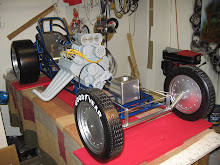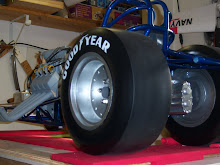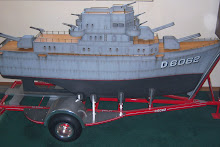
I'm asked quite often, "how do you make all these parts". The Parachutes are a real good example of how a typical, simple, block style piece is made. The valve covers,
bugcatcher scoop, and several similar parts were all made in the same fashion, although a little bit more complicated, the basic principal is the same. This is basic woodcarving, and is probably my favorite type of method.
In the photo below you'll notice that most of these parts break down into very basic shapes. More often than not, the basic shape is formed and pieces are added to the main structure to build it up, which is quite the opposite of carving out the entire shape. The Blower is a good example of this. The smallest inside shape was carved first, and all the other shapes like the ribs, bottom and top decks, front and back plates, and other small details were added to the main part to build it up to the final structure. Every part can be broken down to a very basic shape. The
Bugcatcher Scoop was carved from a single piece of Basswood with the only part being added to it was the thin leading edge that makes up the opening on the front.


The Chutes start out as a simple block of Basswood cut to overall size. Using a hand chisel, the basic shape is carved out.
.

The next step is to make a couple relief cuts to add some depth and to give it the
appearance of the flaps folded together

Next, the random folds are carved and sanded. Anytime that I'll be making more than one part, I work both pieces at the same time to ensure that I end up with somewhat identical pieces.

Here, both parts have been shaped, sanded, and are ready for the first coats of high build Primer. As a side note, I'll sometimes seal the part first with a clear Lacquer or automotive urethane before priming, depends on the piece...

Several coats of Primer have been applied with some minor spot putty to fill in a few imperfections, and they're almost ready for paint.......In the end, I'll add some Brass rings and the
ripchords to finish them up.....
As always, comments and suggestions are welcome....thanks, Mike
 I have finally reached a point on the chassis and motor where I have to call it done. During final paint and assembly I'll probably add a few more details, but I have to draw a line somewhere and this is it. All the work I've done in the last year or so has been the toughest part and I feel I need to move on before I go freakin' nuts!!!!
I have finally reached a point on the chassis and motor where I have to call it done. During final paint and assembly I'll probably add a few more details, but I have to draw a line somewhere and this is it. All the work I've done in the last year or so has been the toughest part and I feel I need to move on before I go freakin' nuts!!!! I'm currently making a lot of minor adjustments to the chassis and body to get the right stance. I'm also taking a lot of reference pics and measurements for the sheetmetal work inside the body and cockpit area. There are also several cardboard mockups that need to be made for the rear spoiler, rocker panel extensions, windshield and side windows.
I'm currently making a lot of minor adjustments to the chassis and body to get the right stance. I'm also taking a lot of reference pics and measurements for the sheetmetal work inside the body and cockpit area. There are also several cardboard mockups that need to be made for the rear spoiler, rocker panel extensions, windshield and side windows.






.JPG)
.JPG)
.JPG)
.JPG)

 The center caps were cut on the lathe from a piece of Oak. After prime and paint, they were temporarily held in place with a few spots of silicone. These will be
The center caps were cut on the lathe from a piece of Oak. After prime and paint, they were temporarily held in place with a few spots of silicone. These will be  I'm quite happy with the end result...........
I'm quite happy with the end result........... Details on the engine are coming along nicely. I'm in the process of adding lots of functional hardware that holds the engine parts together. Valve cover bolts and things of that nature are drilled, tapped and threaded, and the threads are then
Details on the engine are coming along nicely. I'm in the process of adding lots of functional hardware that holds the engine parts together. Valve cover bolts and things of that nature are drilled, tapped and threaded, and the threads are then 




















 The throttle linkage has all been soldered up, and it works too!!!...
The throttle linkage has all been soldered up, and it works too!!!... All parts are still a little rough at this point and will need some more
All parts are still a little rough at this point and will need some more  Brass throttle pedal
Brass throttle pedal Oil pressure gauge
Oil pressure gauge Gauge temporarily mounted, waiting for wiring.
Gauge temporarily mounted, waiting for wiring. Brake handle and master cylinder.
Brake handle and master cylinder. As always, comments and suggestions are welcome....Mike
As always, comments and suggestions are welcome....Mike I'm asked quite often, "how do you make all these parts". The Parachutes are a real good example of how a typical, simple, block style piece is made. The valve covers,
I'm asked quite often, "how do you make all these parts". The Parachutes are a real good example of how a typical, simple, block style piece is made. The valve covers, 










